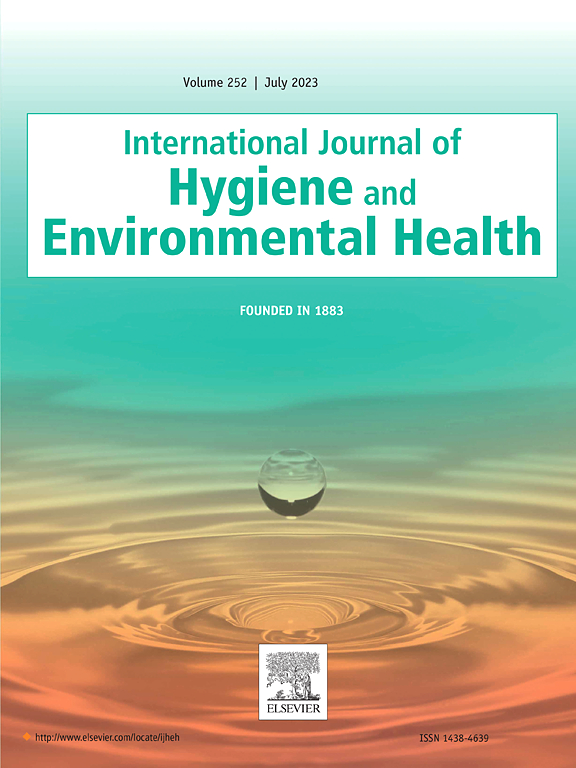评估德国环境样本库(2000-2021 年)尿液样本中紫外线过滤器 DHHB 的暴露情况:评估 DHHB 中邻苯二甲酸二正己酯潜在杂质的影响。
IF 4.4
2区 医学
Q1 INFECTIOUS DISEASES
International journal of hygiene and environmental health
Pub Date : 2025-03-20
DOI:10.1016/j.ijheh.2025.114565
引用次数: 0
摘要
人体生物监测(HBM)已成为评估新兴化学品暴露的重要工具。我们分析了来自德国环境标本库(ESB)的250个24小时尿液样本,这些样本收集于2000年至2021年之间,用于暴露于二乙胺羟基苯甲酰己基苯甲酸酯(DHHB),这是一种越来越多用于防晒霜的紫外线过滤器。检测3种主要代谢物:2-(4-二乙胺)-、2-(4-乙胺)-和2-(4-氨基)-2-羟基苯甲酰苯甲酸(DHB、EHB、AHB),检出率分别为18°%、13°%和87°%。虽然EHB和DHB是DHHB特异性的,但AHB提示其他暴露源,因此对DHHB暴露的评估不可靠。2012年首次发现DHB和EHB,此后检出率有所增加。中位日摄入量为37 ng/kg bw/d,远低于得出的无影响水平2900 mg/kg bw/d,表明DHHB暴露的风险较低。然而,由于所分析的ESB样本是在冬季收集的,因此它们可能反映了来自其他产品和环境的暴露,而不是与防晒霜有关的暴露。最近,人们开始关注DHHB杂质邻苯二甲酸二己酯(DnHexP),这是一种在欧盟未获批准的生殖毒物。口服DHHB给药实验的回顾性分析确实揭示了DnHexP代谢物(MnHexP、氧化5-OH-MnHexP和5-oxo-MnHexP)与杂质相关的剂量依赖性排泄。由于剂量分配的不确定性,仅推导出MnHexP的粗略排泄分数为45°%。我们的研究结果表明,DHHB杂质DnHexP可能导致使用受DHHB污染产品的防晒霜用户暴露于DnHexP。鉴于DnHexP的毒性,这需要重新评估DHHB在化妆品中的安全性,并在HBM研究中加强DHHB和DnHexP的监测。本文章由计算机程序翻译,如有差异,请以英文原文为准。
Assessing the exposure to the UV filter DHHB in urine samples from the German Environmental Specimen Bank (2000–2021): Evaluating the impact of a potential impurity of di-n-hexyl phthalate in DHHB
Human biomonitoring (HBM) has become a crucial tool for assessing exposure to emerging chemicals. We analyzed 250 24-h urine samples from the German Environmental Specimen Bank (ESB), collected between 2000 and 2021, for exposure to diethylamino hydroxybenzoyl hexyl benzoate (DHHB), a UV filter increasingly used in sunscreens. Three major metabolites were examined: 2-(4-diethylamino)-, 2-(4-ethylamino)-, and 2-(4-amino)-2-hydroxybenzoyl)benzoic acid (DHB, EHB, AHB), with detection rates of 18°%, 13°%, and 87°%, respectively. While EHB and DHB were specific to DHHB, AHB suggested other exposure sources, making it unreliable for assessing DHHB exposure. DHB and EHB were first detected in 2012, with increased detection rates thereafter. The median daily intake of 37 ng/kg bw/d was much lower than the derived no-effect level of 2900 mg/kg bw/d, indicating low risk from DHHB exposure. However, since the analyzed ESB samples were collected in winter, they likely reflect exposure from other products and the environment rather than sunscreen-related exposure. Recently, concerns have emerged regarding the DHHB impurity di-n-hexylphthalate (DnHexP), a reproductive toxicant not authorized in the EU. Retrospective analysis of oral DHHB dosing experiments indeed revealed impurity related dose-dependent excretion of DnHexP metabolites (MnHexP, oxidized 5-OH-MnHexP, and 5-oxo-MnHexP). Due to uncertainties in dose allocation, only a rough excretion fraction of 45°% for MnHexP was derived. Our findings suggest that the DHHB impurity DnHexP may contribute to DnHexP exposure in sunscreen users applying products with contaminated DHHB. Given DnHexP's toxicity, this warrants re-assessment of DHHB's safety in cosmetics and enhanced surveillance of both DHHB and DnHexP in HBM studies.
求助全文
通过发布文献求助,成功后即可免费获取论文全文。
去求助
来源期刊
CiteScore
11.50
自引率
5.00%
发文量
151
审稿时长
22 days
期刊介绍:
The International Journal of Hygiene and Environmental Health serves as a multidisciplinary forum for original reports on exposure assessment and the reactions to and consequences of human exposure to the biological, chemical, and physical environment. Research reports, short communications, reviews, scientific comments, technical notes, and editorials will be peer-reviewed before acceptance for publication. Priority will be given to articles on epidemiological aspects of environmental toxicology, health risk assessments, susceptible (sub) populations, sanitation and clean water, human biomonitoring, environmental medicine, and public health aspects of exposure-related outcomes.

 求助内容:
求助内容: 应助结果提醒方式:
应助结果提醒方式:


